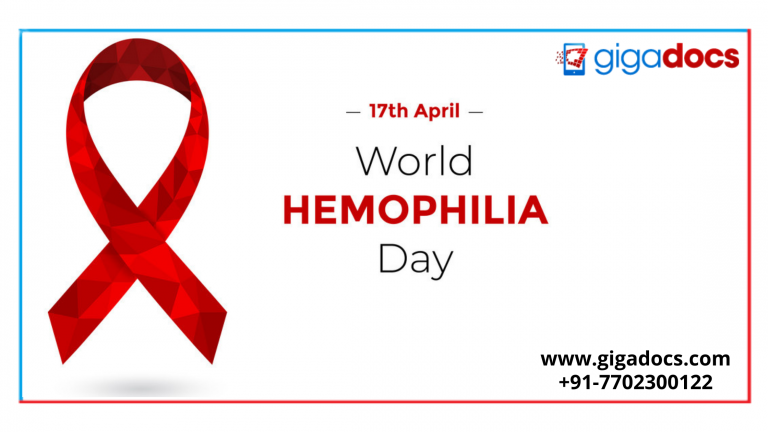Hemophilia is a bleeding disorder that results in excessive bleeding. People who have the disease may bleed for no apparent reason. Hemophilia is a rare disorder that affects the blood’s ability to clot. It’s usually passed down through the generations.
Do you know?
Those with Hemophilia have low levels of Clotting Factor eight (VIII) or Factor nine (IX). These factors determine the severity of hemophilia, leading to the following complications:
- Joint bleeding can cause chronic joint disease and pain.
- Head and brain bleeding can result in long-term complications such as seizures and paralysis.
Symptoms of Hemophilia
- Bleeding in the joints is a common symptom of hemophilia. This bleeding most commonly affects the ankles, knees, and elbows and may cause joint tightness, swelling, and pain.
- Bleeding in the mouth and gums and bleeding that is difficult to stop after a tooth is lost.
- Bleeding after vaccinations or other shots.
- An infant’s head is bleeding after a difficult delivery.
- Blood in the feces or urine.
- Difficult to stop nosebleeds.
Types of Hemophilia
Hemophilia can come in a variety of forms. The two most common are –
- Hemophilia A, also called Classic Hemophilia, which is caused by a deficiency or reduction in clotting factor VIII.
- Hemophilia B (Christmas Disease) – the lack or decrease of clotting factor IX causes Hemophilia B.
Hemophilia: How Common Is It?
More than 1,36,000 people in India have been diagnosed with cancer (by prevalence). One in every 10,000 male births is affected. Males are far more likely than females to develop the two primary forms of hemophilia. Hemophilia A is the most common type of disorder; it affects 1 in 4,000 to 1 in 5,000 males worldwide. Hemophilia B affects about one out of every 20,000 newborn males worldwide.
Why is Hemophilia called “Royal Disease”?
Hemophilia has afflicted the royal families of England, Germany, Russia, and Spain in the 19th and 20th centuries; hence, it is known as “Royal Disease.”
Queen Victoria, ruler of England from 1837 to 1901, is known to be the carrier of Hemophilia B. Queen Victoria’s family pedigree shows many hemophilic descendants.
| World Hemophilia Day The world celebrates World Hemophilia Day on the 17th of April. The day marks the birth anniversary of Frank Schnabel, the founder of the World Federation of Hemophilia, and aims to raise awareness about Hemophilia. |
Hemophilia Myths
- Myth: Those with hemophilia will bleed to death if they suffer a cut.
- Fact: The truth is that not all bleeds are life-threatening. People with hemophilia may experience bruising or bleeding into their muscles and joints, which can cause long-term damage if it happens frequently.
- Myth: Everyone with hemophilia will become disabled.
- Fact: People with hemophilia may avoid frequent joint bleeds and long-term joint damage if they receive proper preventative (prophylactic) treatment.
- Myth: Children with hemophilia always have a family history of hemophilia.
- Fact: While hemophilia is usually inherited, one-third of cases arise independently.
- Myth: All types of hemophilia involve a clotting factor VIII deficiency.
- Fact: The most common form of hemophilia is Hemophilia A, caused by a lack of clotting factor VIII. Hemophilia B is caused by a deficiency in factor IX, while a deficiency causes hemophilia C in factor XI.
- Myth: Hemophilia A patients all have the same symptoms.
- Fact: Symptoms of hemophilia A vary depending on factor VIII
- Myth: Hemophilia A improves over time.
- Fact: Hemophilia A is a lifelong bleeding disorder caused by a lack of clotting factor VIII, which does not improve with age.
- Myth: People with hemophilia are unable to participate in sports.
- Fact: Those with hemophilia can participate in various sports, including swimming and running, with proper treatment, but rough contact sports are usually not recommended.
- Myth: Only boys and men are affected by hemophilia.
- Fact: Hemophilia gene is linked to chromosome X. Most hemophilia patients are men. Hemophilia can affect women, but it is uncommon.
- Myth: People with hemophilia live for a short time.
- Fact: People with hemophilia today can expect to live a near-normal life expectancy if they can manage their hemophilia properly.
- Myth: Hemophilia can be cured with iron, specific vitamins, and peanuts.
- Fact: Hemophilia has no known cure at present. Replacement therapy for the missing clotting factor VIII and non-factor replacement therapies are currently being used.
- Myth: People with hemophilia only have external bleeds, such as those caused by a cut or graze.
- Fact: People with hemophilia can also experience internal bleeding in their elbow, ankle, and knees.
Hemophilia Diagnosis
Hemophilia must be diagnosed and managed early to avoid complications. These complications include intracranial hemorrhage, compartment syndrome, chronic anemia, and hemarthrosis.
Many people who have had hemophilia in their families will request that their baby be tested shortly after birth. Doctors will conduct specific blood tests to determine if the blood is properly clotting. These blood tests are used to determine the severity of Hemophilia.
Treating Hemophilia with Gigadocs
If you suspect you or your loved one has signs or symptoms of hemophilia, we advise you to get consultations with the best hematologist around you. You can easily search for them on the Gigadocs app. To get started, book a blood test (Home Sample collection available through Gigadocs app) for the initial tests and diagnosis. Download the Gigadocs app to avail all the various healthcare benefits available for your complete family:
Download the Gigadocs App to reach the best medical specialists around you-
- IOS App – apple.co/2W2iG4V
- Android App – bit.ly/33AQoRC
To know more, e-mail at info@gigadocs.com




